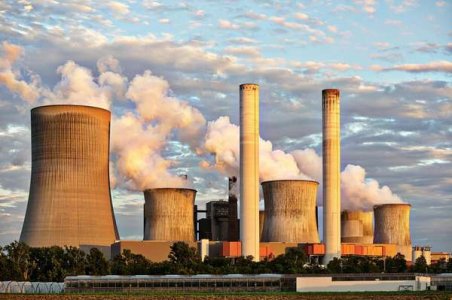A hidden cancer risk strikes 70,000 Americans annually—Find out what it is NOW!
- Replies 0
In an age where we're more aware than ever of the things that can affect our health, a recent study has brought to light a startling connection that could be impacting thousands of Americans each year.
The culprit? Something as seemingly innocuous as the air we breathe.
What type of air is this, exactly? Let’s take a deep dive into the details of this shocking discovery so we know how to protect ourselves.
The study in question, published in the journal Scientific Reports, has revealed a shocking link between air pollution and a group of cancers known as head and neck cancers (HNC). These include cancers of the throat, mouth, and other areas in the upper aerodigestive tract.
Alarmingly, an estimated 71,100 Americans are expected to be diagnosed with HNC in 2024 alone. Researchers have pinpointed a specific type of air pollution called PM2.5, or particulate matter smaller than 2.5 microns, as a significant risk factor.

The study found that exposure to PM2.5 increased the risk of developing HNC by 24 percent within five years after exposure.
What's more, even a single year of exposure to PM2.5 can increase the risk by 16 percent. These particles are not just the byproduct of industrial processes; they can also come from everyday activities like burning candles, using certain cleaners, or air fresheners in our homes.
The Midwest and Southeast of the United States, regions with economies that rely heavily on manufacturing, agriculture, and energy, have particularly high rates of HNC. Its prominence is specifically severe in states such as California, Georgia, and Utah.
These industries are known to be significant producers of air pollution, including PM2.5. It can also be generated through other industrial processes such as fuel burning and manufacturing, but also through simple household activities like burning candles, using certain cleaners or air fresheners.
Amanda Dilger of the Center for Surgery and Public Health and Massachusetts Eye and Ear states, “Environmental health and personal health are inextricably linked.”
The study's findings are based on data from the Surveillance, Epidemiology, and End Results (SEER) national cancer database, which tracks cancer cases and collects follow-up information on patients.

By linking this data to county-level information on PM2.5 pollution, alcohol use, and smoking from 2002-2012, researchers were able to draw a significant association between PM2.5 levels and the incidence rate of HNC.
The harmful effects of particulate matter on human health have been well documented, with the International Agency for Research on Cancer (IARC) classifying air pollution, specifically PM2.5, as a carcinogen known to cause cancer in humans.
While lung cancer has been the primary focus, cells in the head and neck are also particularly vulnerable to air pollution. Patients had been diagnosed with oral cavity, oropharynx, larynx, hypopharynx, sinonasal and middle ear cancers.
Dr. John Cramer, the lead author of the study and an associate professor of otolaryngology at Wayne State University in Detroit, explains that “the link to head and neck cancer comes from what we breathe to that material affecting the lining in the head and neck.”
The implications of air pollution extend beyond cancer.
Other studies have found connections between air pollution exposure and increased rates of miscarriage, disruptions in pregnancy hormones, harmful inflammation, and negative impacts on fetal development.
As research continues to uncover the myriad ways air pollution harms human health, there is a growing push for improved air quality standards to mitigate the effects of these dangerous substances.
“Our study highlights the need to improve air quality standards in order to decrease the risk of developing cancer, including head and neck cancer,” Dr Dilger says.
Aside from cancer and other aforementioned illnesses, air pollution can also harm your skin. In earlier news, air pollution was discovered to trigger a certain skin disease. You can read more about it in this story here.
While the findings of this study may be concerning, they also empower us with knowledge. Understanding the risks associated with air pollution can motivate us to advocate for cleaner air standards and make informed choices in our daily lives.
Here are some steps you can take to reduce your exposure to PM2.5 and protect your health:
1. Monitor air quality reports and limit outdoor activities when pollution levels are high.
2. Use air purifiers in your home to reduce indoor levels of particulate matter.
3. Opt for natural cleaning products and avoid burning candles or using air fresheners that can release pollutants.
4. Support policies and initiatives aimed at reducing air pollution in your community.

Have you or someone you know been affected by head and neck cancer? Are you concerned about the air quality in your area? Share your experiences and thoughts in the comments below!
The culprit? Something as seemingly innocuous as the air we breathe.
What type of air is this, exactly? Let’s take a deep dive into the details of this shocking discovery so we know how to protect ourselves.
The study in question, published in the journal Scientific Reports, has revealed a shocking link between air pollution and a group of cancers known as head and neck cancers (HNC). These include cancers of the throat, mouth, and other areas in the upper aerodigestive tract.
Alarmingly, an estimated 71,100 Americans are expected to be diagnosed with HNC in 2024 alone. Researchers have pinpointed a specific type of air pollution called PM2.5, or particulate matter smaller than 2.5 microns, as a significant risk factor.

These tiny particles can penetrate deep into the lungs and even enter the bloodstream, posing a serious health risk. Image source: Pexels.
The study found that exposure to PM2.5 increased the risk of developing HNC by 24 percent within five years after exposure.
What's more, even a single year of exposure to PM2.5 can increase the risk by 16 percent. These particles are not just the byproduct of industrial processes; they can also come from everyday activities like burning candles, using certain cleaners, or air fresheners in our homes.
The Midwest and Southeast of the United States, regions with economies that rely heavily on manufacturing, agriculture, and energy, have particularly high rates of HNC. Its prominence is specifically severe in states such as California, Georgia, and Utah.
These industries are known to be significant producers of air pollution, including PM2.5. It can also be generated through other industrial processes such as fuel burning and manufacturing, but also through simple household activities like burning candles, using certain cleaners or air fresheners.
Amanda Dilger of the Center for Surgery and Public Health and Massachusetts Eye and Ear states, “Environmental health and personal health are inextricably linked.”
The study's findings are based on data from the Surveillance, Epidemiology, and End Results (SEER) national cancer database, which tracks cancer cases and collects follow-up information on patients.

The findings emphasize the importance of environmental health, with calls for increased research, awareness, and efforts to mitigate pollution to reduce the risk of cancer. Image source: Pexels.
By linking this data to county-level information on PM2.5 pollution, alcohol use, and smoking from 2002-2012, researchers were able to draw a significant association between PM2.5 levels and the incidence rate of HNC.
The harmful effects of particulate matter on human health have been well documented, with the International Agency for Research on Cancer (IARC) classifying air pollution, specifically PM2.5, as a carcinogen known to cause cancer in humans.
While lung cancer has been the primary focus, cells in the head and neck are also particularly vulnerable to air pollution. Patients had been diagnosed with oral cavity, oropharynx, larynx, hypopharynx, sinonasal and middle ear cancers.
Dr. John Cramer, the lead author of the study and an associate professor of otolaryngology at Wayne State University in Detroit, explains that “the link to head and neck cancer comes from what we breathe to that material affecting the lining in the head and neck.”
The implications of air pollution extend beyond cancer.
Other studies have found connections between air pollution exposure and increased rates of miscarriage, disruptions in pregnancy hormones, harmful inflammation, and negative impacts on fetal development.
As research continues to uncover the myriad ways air pollution harms human health, there is a growing push for improved air quality standards to mitigate the effects of these dangerous substances.
“Our study highlights the need to improve air quality standards in order to decrease the risk of developing cancer, including head and neck cancer,” Dr Dilger says.
Aside from cancer and other aforementioned illnesses, air pollution can also harm your skin. In earlier news, air pollution was discovered to trigger a certain skin disease. You can read more about it in this story here.
While the findings of this study may be concerning, they also empower us with knowledge. Understanding the risks associated with air pollution can motivate us to advocate for cleaner air standards and make informed choices in our daily lives.
Here are some steps you can take to reduce your exposure to PM2.5 and protect your health:
1. Monitor air quality reports and limit outdoor activities when pollution levels are high.
2. Use air purifiers in your home to reduce indoor levels of particulate matter.
3. Opt for natural cleaning products and avoid burning candles or using air fresheners that can release pollutants.
4. Support policies and initiatives aimed at reducing air pollution in your community.
Key Takeaways
- Researchers have found a significant link between air pollution, specifically PM2.5 pollutants, and an increased risk of head and neck cancers (HNC) in Americans.
- Exposure to PM2.5 pollution is shown to increase the risk of developing HNC by 24% after five years and by 16% within just one year.
- The study analyzed data on HNC cases from 2002 to 2012 and linked them to county-level data on PM2.5 pollution, alcohol use, and smoking.
- The findings emphasize the importance of environmental health, with calls for increased research, awareness, and efforts to mitigate pollution to reduce the risk of cancer.
Have you or someone you know been affected by head and neck cancer? Are you concerned about the air quality in your area? Share your experiences and thoughts in the comments below!
Last edited:






